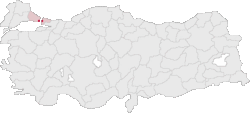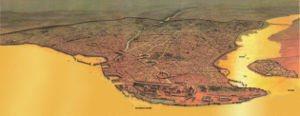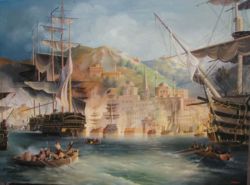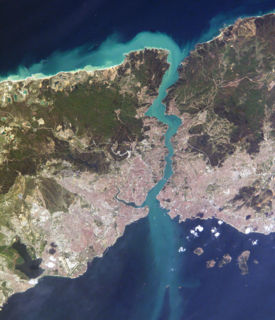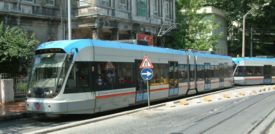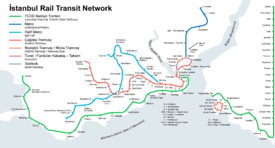Istanbul
2007 Schools Wikipedia Selection. Related subjects: European Geography
 Front to back: Sultan Ahmed Mosque, Hippodrome of Constantinople, Hagia Sophia, Walls of Constantinople, Hagia Irene, Topkapi Palace |
|
| Map | |
|
Location in Turkey |
|
| Overview | |
| Province | Istanbul |
| Total Population | 10,034,830 (2006) |
| Area | 1,538,77 km² |
| Population density | 6521 inh./km² |
| Elevation | 100 m |
| Coordinates | 41°00′ N 29°00′ E |
| Postal code | 34010 to 34850 and 80000 to 81800 |
| Area code | (+90) 212 (European side) (+90) 216 (Asian side) |
| Licence plate code | 34 |
| Mayor | Kadir Topbaş ( Justice and Development Party) |
| Website | http://www.ibb.gov.tr/ |
Istanbul ( Turkish: İstanbul, Greek: Κωνσταντινούπολη Konstandinúpoli, historically known in English as Constantinople; see other names) is Turkey's most populous city, and its cultural and economic centre. The city is the capital of the Province of Istanbul. It is located at 41° N 28° E, on the Bosphorus strait, and encompasses the natural harbour known as the Golden Horn ( Turkish: Haliç), in the northwest of the country. Istanbul extends both on the European ( Thrace) and on the Asian ( Anatolia) side of the Bosphorus, and is thereby the only metropolis in the world which is situated on two continents. Istanbul is also the only city in the world which served as the capital to three different Empires: The Roman Empire (330-395), Byzantine Empire (395-1453) and the Ottoman Empire (1453-1923). In 1923, following the establishment of the Republic of Turkey, the capital was moved to Ankara.
According to the 2000 census, the population is 8,803,468 (city proper) and 10,018,735 (metro area), making it the second largest city in Europe. The census bureau estimate for July 20, 2005 is 11,322,000 for the province, which is generally considered as the metropolitan area, making it one of the twenty largest metropolitan areas in the world. The city was chosen as the European Capital of Culture for 2010 (along with Pécs, Hungary and Essen, Germany).
The city has had many names through the years and according to the culture, language and religion of its inhabitants. Byzantium, Constantinople and Stamboul are examples that may still be found in active use. The etymology of the names and an extended list of old names can be found under Istanbul (etymology). It has also been nicknamed "The City on Seven Hills" because the historic peninsula (the oldest part of the city) was built on seven hills, also represented with seven mosques, one at the top of each hill.
"The Historic Areas of Istanbul" were added to the UNESCO World Heritage list in 1985.
History
Byzantium
Byzantium was originally settled by Greek colonists from Megara in 667 BC and named after their king Byzas. The name "Byzantium" is a transliteration of the original Greek name Βυζάντιον; (Demotic Modern Greek spells this Βυζάντιο, pronounced IPA /vi.ˈza.ⁿdjo/).
After siding with Pescennius Niger against the victorious Septimius Severus the city was besieged by Rome and suffered extensive damage in AD 196. Byzantium was rebuilt by the Roman Emperor Septimius Severus and quickly regained its previous prosperity.
Byzantine Empire
The location of Byzantium attracted Constantine the Great and in 330 he refounded it as Nova Roma, or Constantinoupolis after himself ( Constantinople, Greek: Konstantinoupolis or Κωνσταντινούπολις) after a prophetic dream was said to have identified the location of the city. The name Nova Roma never came into common use. The Eastern Roman Empire which had its capital in Constantinople from then until the conquest of the empire in 1453, has often been called the Byzantine Empire or Byzantium by modern scholars.
The combination of imperialism and location would play an important role as the crossing point between two continents (Europe and Asia), and later a magnet for Africa and others as well, in terms of commerce, culture, diplomacy, and strategy. At a strategic position, Constantinoupolis was able to control the route between Asia and Europe, as well as the passage from the Mediterranean Sea to the Efxinos Pontos (Black Sea).
Constantinople was the capital of the Eastern Roman Empire, also known as the Byzantine Empire. In Byzantine times the Greeks called Constantinople i Poli ("The City"), since it was the centre of the Greek world and for most of the Byzantine period, the largest city in Europe. It was captured and sacked by the Fourth Crusade in 1204 and then re-captured by Nicaean forces under the command of Michael VIII Palaeologus in 1261.
With the fall of Rome and the Western Roman Empire, the name of the city was changed to Constantinople and became the sole capital of what historians now call the Byzantine Empire. This empire was distinctly Greek in culture, and became the centre of Greek Orthodox Christianity after an earlier split with Rome, and was adorned with many magnificent churches, including Hagia Sophia, once the world's largest cathedral. The seat of the Patriarch of Constantinople, spiritual leader of the Eastern Orthodox Church, remains.
Ottoman Empire
On 29 May 1453, Sultan Mehmet II “the Conqueror”, entered Constantinople after a 53–day siege during which his cannon had torn a huge hole in the Walls of Theodosius II. Istanbul became the third capital of the Ottoman Empire in 1453.
The Grand Bazaar and Topkapı Palace were erected in the years following the Turkish conquest. Religious foundations were endowed to fund the building of mosques such as the Fatih and their associated schools and baths. The city had to be repopulated by a mixture of force and encouragement. People from all over the empire moved to Istanbul, and Jews, Christians and Muslims lived together in a cosmopolitan society.
Süleyman’s reign was a time of great artistic and architectural achievements. The architect Sinan designed many mosques and other great buildings in the city, while Ottoman arts of ceramics and calligraphy also flourished.
Sufi orders which were so widespread in the Islamic world and who had many followers who had actively participated in the conquest of the city came to settle in the capital. During Ottoman times over 100 Tekkes were active in the city alone. Many of these Tekkes survive to this day some in the form of mosques while others as museums such as the Jerrahi Tekke in Fatih, the Sunbul Effendi and Ramazan Effendi Mosque and Turbes also in Fatih, the Galata Mevlevihane in Beyoğlu, the Yahya Effendi Tekke in Besiktas, and the Bektashi Tekke in Kadıköy, which now serves Alevi Muslims as a Cem Evi. The city was modernized from the 1870s onwards with the building of bridges, the creation of a proper water system, the use of electric lights, and the introduction of streetcars and telephones.
Republic of Turkey
When the Republic of Turkey was founded in 1923, the capital was moved from Istanbul to Ankara. The city's name 'Constantinople' had remained, in the form 'Konstantiniyye', though the Ottoman Empire. Outside the Empire, it was often known as Stambul or Stamboul. The Republic changed the name to Istanbul in 1930.
In the early years of the republic, Istanbul was overlooked in favour of the new capital Ankara but, during the 1950s and 1960s, Istanbul underwent great structural change. The city's once numerous and prosperous Greek community, remnants of the city's Greek origins, dwindled in the aftermath of the 1955 Istanbul Pogrom with most Greeks in Turkey leaving their homes for Greece.
In the 1950s the government of Adnan Menderes sought to develop the country as a whole and new roads and factories were constructed throughout the country. Wide modern roads were built in Istanbul but some, unfortunately, were at the expense of historical buildings within the city.
During the 1970s the population of Istanbul began to rapidly increase as people from Anatolia migrated to the city to find employment in the many new factories that were constructed on the outskirts of the city. This sudden sharp increase in the population caused a rapid rise in housing development (some of poor quality resulting in great death and injury during the frequent earthquakes that hit the city) and many previously outlying villages became engulfed into the greater metropolis of Istanbul. Many Turks who have lived in Istanbul for over 30 or more years can still recollect how areas such as large parts of Maltepe, Kartal, Pendik, and others were green fields when they were young. Other areas such as Tuzla were nothing more than sleepy villages.
In November 2003, two bombings were carried out on two days. They have been blamed on the al-Qaeda terrorist network.
Geography
Location
Istanbul encloses the southern Bosporus which puts the city on two continents – the western portion of Istanbul is in Europe, while the eastern portion is in Asia. The city boundaries cover a surface of 1,539 square kilometers. The Metropol region, or the province of Istanbul, has an area of 5,220 square kilometers.
Geology
Istanbul is situated near the North Anatolian fault line, which runs from the northern Anatolia to the Marmara Sea. Two tectonic plates, the African and the Eurasian, push together here. This fault line has been responsible for several deadly earthquakes in the region in contemporary history. In 1509, a catastrophic quake caused a tsunami which broke over the sea-walls of the city destroying over 100 mosques and killing 10,000 people. In 1766, the Eyüp mosque was completely destroyed. The 1894 quake collapsed many parts of covered bazaar in Istanbul. A devastating quake in August 1999 in Kocaeli left 18,000 dead and in the winter of 2001 in the province of Afyon 41 people died. In all of these earthquakes, the devastating effects are a result of the close settlement and poor construction of buildings. Earth scientists prognosticate another quake, possibly measuring 7.0 on the Richter scale, occurring before 2025.
Climate
Temperate-Continental The city has hot and humid summers with cold, rainy and sometimes snowy winters. Yearly precipitation for Istanbul averages 870 mm. Humidity is often rather high which can make temperatures feel much warmer or colder than they actually are. The average maximum temperature during the winter months varies between 7°C (46° F) and 9°C (50° F). Snowfall is quite common, snowing for a week or two during the winter season, but it can be heavy once it snows. It is most likely to occur between the months of December and March. The summer months of June through September bring average daytime temperatures of 28 °C (82 °F).
The warmest month is July with on the average 23.2 degrees Celsius, coldest January with 5.4 degrees Celsius on the average. The highest recorded temperature in Istanbul is 40.5 °C (105 °F) (August 2000), with the lowest being –16.1 °C (3 °F) (February 1927). The weather becomes slightly cooler as one moves toward eastern Istanbul.
The city is quite windy, having an average wind speed of 17 km/h (11 mph).
Summer is by far the driest season, although there is no real summer drought such as occurs further west, and so the climate cannot be considered truly Mediterranean.
| Month | Maximum Temperature | Lowest temperature | Days with Rain | Sunshine | ||
|---|---|---|---|---|---|---|
| Average | Absolute | Average | Absolute | (day.) | ||
| January | 9 | 19 | 3 | − 13 | 18 | 2.6 |
| February | 9 | 24 | 2 | − 16 | 15 | 3.3 |
| March | 11 | 27 | 3 | − 11 | 14 | 4.4 |
| April | 16 | 33 | 7 | − 2 | 9 | 6.6 |
| May | 21 | 34 | 12 | 2 | 8 | 8.9 |
| June | 26 | 37 | 16 | 6 | 5 | 10.8 |
| July | 29 | 39 | 18 | 11 | 4 | 11.7 |
| August | 29 | 41 | 20 | 10 | 3 | 11.3 |
| September | 25 | 38 | 15 | 6 | 6 | 8.5 |
| October | 21 | 33 | 12 | 3 | 10 | 6.2 |
| November | 15 | 27 | 9 | − 7 | 13 | 4.6 |
| December | 11 | 22 | 5 | − 12 | 17 | 2.3 |
City arrangement
Istanbul's districts are divided into three main areas:
- The Historic Peninsula of old İstanbul comprises the districts of Eminönü and Fatih. This area lies on the southern shores of the Golden Horn which separates the old city centre from the northern and younger parts of the European side. The Historic Peninsula ends with the Theodosian Land Walls in the west. The peninsula is surrounded by the Sea of Marmara on the south and the Bosphorus on the east.
- North of the Golden Horn are the historical Beyoğlu and Beşiktaş districts, where the last Sultan's palace is located, followed by a chain of former villages such as Ortaköy and Bebek along the shores of the Bosphorus. On both the European and Asian sides of the Bosphorus, wealthy Istanbulites built luxurious chalet mansions, called yalis, which were used as summer residences.
- The quarters of Üsküdar and Kadıköy which are located on the Asian side were originally independent cities, like Pera also used to be. Today they are full of modern residential areas and business districts, and are home to around one-third of Istanbul's population.
Highrise office and residential buildings are mostly located on the northern areas of the European side, and especially in the business and shopping districts of Levent, Maslak and Etiler which are located between the Bosphorus Bridge and Fatih Sultan Mehmet Bridge.
Due to Istanbul's exponential growth during the second half of the 20th century, a significant portion of the city consist of gecekondus, a Turkish word created in the 1940s meaning ‘built overnight’ and refers to the illegally constructed squatter buildings that comprise entire neighbourhoods and run rampant outside the historic centers of Turkey’s largest cities, especially Istanbul, Ankara, İzmir, and Bursa. According to the official definition stated in the Gecekondu Act of 1966, these neighbourhoods are typically built on abandoned land or on lands owned by others, without the permission of the landowner, and do not obey building codes and regulations. At present, gecekondu areas are being tried to be demolished and replaced by modern mass-housing compounds such as My World, Incity, Uphill Court and similar projects developed by the state-owned TOKI.
Lifestyle
Cultural activity, tourism and commerce will continue to be important to the life of the city. However, population growth, traffic, preventing disorganized housing, restoration of historic buildings and planning a 3rd motorway transition to the Bosphorus continue to be issues. Daily life in Istanbul is colorful and vibrant and continues side by side with many carefully protected Roman, Byzantine and Turkish monuments. Istanbul is often considered the capital of Turkey in terms of commerce, entertainment, culture, education, shopping, tourism and art. More than half of the population lives and works on the European side. The large number of people living in the residential areas on the Anatolian side use bridges and ferries to commute to work in a city that has been the most popular stop for voyagers throughout history.
Istanbul is becoming increasingly colorful in terms of its rich social, cultural and commercial activities. Along with Turkish restaurants, Far eastern and other cuisines are growing in number alongside many newly opened restaurants. While world famous pop stars fill stadiums, activities like opera, ballet and theatre continue throughout the year. During seasonal festivals world famous orchestras, chorale ensembles, concerts and jazz legends can be found often playing to a full house. Shows are hosted at a number of locations including historical sites such as Hagia Irene, Rumeli Fortress, Yedikule, the courtyard of Topkapı Palace, and Gülhane park; as well as the Ataturk Cultural centre, Cemal Reşit Rey concert hall and other open air and modern theatre halls. For those who like night life, there are a number of clubs, discos, bars, pavillions and restaurants with live music. The clubs, restaurants and discoteques increase in number and move to open air spaces in the summer.
The urban landscape is constantly changing. Traditionally Ottoman buildings were built of wood. In the last decades, numerous tall structures were built around the city to accommodate a rapid growth in population. Surrounding towns were absorbed into Istanbul as the city grew rapidly outwards. Infrastructure successes since the mid 1990s include the resolution of the garbage problem, improved traffic conditions and improved air quality due to the increased use of natural gas. Nevertheless, air and water pollution created by the numerous factories, motor vehicles and private households as well as noise pollution created by traffic continue to concern the population of Istanbul. Diseases such as bronchitis and asthma are far more common among the inhabitants of the city's Gecekondu areas largely because of these poorer, densely populated areas' proximity to industry.
Leisure and relaxation
The most popular places for swimming in the city are in Bakırköy, Küçükçekmece, Sarıyer and the Bosphorus. Outside the city are the Marmara Sea's Princes' Islands, Silivri and Tuzla; as well as Kilyos and Şile on the Black Sea. The Princes' Islands (Prens Adaları) are a group of islands in the Marmara Sea, south of the quarters Kartal and Pendik. Pine and stone-pine wooden neoclassical and art nouveau-style Ottoman era summer mansions from the nineteenth and early twentieth centuries, horse-drawn carriages (motor vehicles are not permitted) and fish restaurants make them a popular trip destination. They can be reached by ferry boats and high-speed ferries (Deniz otobüsü) from Eminönü and Kartal. Of the nine islands, four are settled. Şile is a distant and well-known Turkish seaside resort on the Black Sea, 50 kilometers from Istanbul. Unspoiled white sand beaches can be found outside of Şile. Kilyos is a small calm seaside resort not far from the northern European entrance of the Bosphorus at the Black Sea. The place has good swimming possibilities and has became popular in the last years among the inhabitants of Istanbul as a place for excursions. Kilyos offers a beach park with (fish) restaurants and discotheques.
Newsweek magazine recently named Istanbul the "hippest city of Europe", referring to it as the " Turkish delight":
| After so many decades of trying to become Western, Istanbul glories in the rediscovery of a modern identity. European or not, it is one of the coolest cities in the world. There is such richness, the city is still thickly atmospheric, with bazaars, Byzantine churches and Ottoman mansions pretty much everywhere. |
Demographics
- Further reading Demographics of Turkey
Overview
"If one had but a single glance to give the world, one should gaze on Istanbul."
Lamartine's famous poetic quote reveals his love for Istanbul, described as embracing two continents, with one arm reaching out to Asia and the other to Europe.
The urban landscape of Istanbul is shaped by many communities. The most important and most populous major religion is Islam. Religious minorities include Greek Orthodox Christians, Armenian Christians, and Sephardic Jews. In Istanbul small boroughs are inhabited by ethnic Armenians, Jews and Greeks. In some quarters, such as Kuzguncuk, an Armenian Church sits next to a synagogue, and on the other side of the road a Greek-Orthodox church is found beside a mosque. The seat of the Patriarch of Constantinople, spiritual leader of the Greek Orthodox Church is in Istanbul. Also based here are, the archbishop of the Turkish-Orthodox community, an Armenian archbishop and the Turkish Grand- Rabbi.
The city is traditionally the seat of the Ecumenical Patriarch, to some Orthodox churches and seat of an Armenian archbishop as well as the archbishop of the Turkish-Orthodox community. The everyday life of the Armenian and Greek minorities still living in Istanbul changed after the First World War due to discrimination and constant repression. In 1942 came the introduction of a special wealth tax (varlik vergisi). In 1964, all Greeks (around 100,000) without Turkish citizenship residing in Turkey were deported. Today, most of Turkey's Greek and Armenian minorities live in or near Istanbul. Beside the Levantines, who are the descendants of European traders who had started trading outposts in the Ottoman Empire, there is also a small, scattered number of Bosphorus Germans. A number of places reflect past movements of different peoples into Istanbul, most notably Arnavutköy (Albanian village), Polonezköy (Polish village) and Yeni Bosna (New Bosnia).
The Sephardic Jews have lived in the city for over 500 years. They fled in 1492 from the Iberian Peninsula, when they were forced to convert to Christianity after the fall of the Moorish Kingdom of Andalucia. Ottoman Sultan Bayezid II ( 1481- 1512) sent a sizable fleet to Spain in order to save the Sephardic Jews. More than 200,000 fled first to Tangier, Algiers, Genova and Marseille, later to Salonica and finally to Istanbul. The Sultan granted over 93,000 of these Spanish Jews to take refuge in the Ottoman Empire. In Istanbul more than 20,000 Sephardic Jews still remain today. Altogether 20 synagoges are to be found in the city, the most important of them being the Neve Shalom Synagogue ianugurated in 1951, in the Beyoglu quarter. The Turkish Grand Rabbi in Istanbul (currently Ishak Haleva) presides over community affairs.
Population growth
The population of the metropolis more than tripled during the 25 years between 1980 and 2005. Roughly 70% of all Istanbulites live in the European section and around 30% in the Asian section. Due to high unemployment in the southeast of Turkey, many people from that region migrated to Istanbul, where they established themselves in the outskirts ( Gaziosmanpaşa, Ziya Gökalp). . Migrants, predominantly from eastern Anatolia arrive in Istanbul expecting improved living conditions and employment, which usually end with little success. This results each year with new Gecekondus at the outskirts of the city, which are later developed into neighbourhoods and integrated into the greater metropolis.
The following overview shows the numbers of inhabitants by year. Population tallies up to 1914 are estimated with variations of up to 50% depending upon researcher. The numbers from 1927 to 2000 are results of censuses. The numbers of 2005 and 2006 are based on computer simulation forecasts. The doubling of the population of Istanbul between 1980 and 1985 is due to a natural increase in population as well as the expansion of municipal limits.
|
|
Places of interest
Istanbul was a cultural and ethnic melting pot. As a result, there are many historical mosques, churches, synagogues, and palaces to visit in the city (for relevant collection of pictures try, ). Modern Istanbul also includes skyscrapers, malls, metros, etc.
|
Galata Tower rising above the medieval Genoese citadel |
|||
|
Levent |
|||
|
Entrance of Metrocity shopping mall in Levent |
Armani Café and Gucci on Teşvikiye Avenue in Nişantaşı, the fashion district of Istanbul |
Bosphorus Bridge during Republic Day celebrations |
Museums, Monuments and Other Buildings
Alphabetical Order
|
|
Markets, neighborhoods and places
- Anadoluhisarı
- Arnavutköy
- Bebek
- Beylerbeyi
- Beyoğlu
- Bosphorus
- Çengelköy
- Eminönü
- Emirgan
- Eyüp
- Fener
- Galata
- Golden Horn
- Istiklal Avenue
- Kandilli
- Kanlıca
- Karaköy
- Nişantaşı
- Ortaköy
- Princes' Islands
- Rumelihisarı
- Sarıyer
- Taksim Square
- Tarabya
- The Grand Bazaar
- The Spice Bazaar
- Üsküdar
- Yedikule
- Yeniköy
- Yeşilköy
The cross-continent European walking route E8 trail begins/ends here, running 4700 km to Cork, Ireland.
Education
Istanbul holds some of the finest institutes of higher education in Turkey, including a number of public and private universities. Most of the reputable universities are public, but in recent years there has also been an upsurge in the number of private universities.
Universities
Among the well-known public institutions are Istanbul Technical University ( Istanbul Teknik Üniversitesi (İTÜ)), Bosphorus University ( Boğaziçi Üniversitesi), Galatasaray University, University of Istanbul ( İstanbul Üniversitesi (İÜ)), University of Marmara ( Marmara Üniversitesi), Yildiz Technical University ( Yıldız Teknik Üniversitesi) and Mimar Sinan Fine Arts University (Mimar Sinan Güzel Sanatlar Üniversitesi).
Some of the private institutions include Istanbul Commerce University ( İstanbul Ticaret Üniversitesi), Bahçeşehir University ( Bahçeşehir Üniversitesi), Koç University ( Koç Üniversitesi), Sabanci University ( Sabancı Üniversitesi), Bilgi University ( İstanbul Bilgi Üniversitesi), Istanbul Kultur University , Isik University ( Işık Üniversitesi), Yeditepe University ( Yeditepe Üniversitesi), Fatih University ( Fatih Üniversitesi), Maltepe University ( Maltepe Üniversitesi), Kadir Has University ( Kadir Has Üniversitesi), Haliç University (Haliç Üniversitesi), Dogus University (Doğuş Üniversitesi) and Beykent University (Beykent Üniversitesi).
High schools
- There are many classical, national and private high schools, like the İstanbul Lisesi (Istanbul Highschool) in Cagaloglu, Galatasaray High School in Beyoğlu, and Kadikoy Anadolu Lisesi in Moda.
- Private High Schools, e.g. Amerikan Robert Lisesi (American Robert College), Uskudar Amerikan Lisesi ( Uskudar American Academy), Deutsche Schule Istanbul (Private German school), Lycee Saint Michel (Private French school) and Italian High School (Liceo Italiano) or some private Turkish institutions, such as Koç Özel Lisesi ( Koç School)
- Anadolu Liseleri ("Anatolian Highshools"), originally furnished for the Turkish children returned home from the foreign country, e.g. the Üsküdar Anadolu Lisesi with German as first foreign language and technical instruction on German Professional training-technical resuming schools.
- Science High Schools. Science High schools were established with the aim of providing education to exceptionally gifted mathematics and science students; providing a source for the training of high-level scientists, in order to meet the needs of nation; encouraging students to engage in research activities ;providing facilities for students interested in working on inventions and discoveries; serving as labarotory for procedures to be implemented in the science and mathematics programs of other secondary schools. These schools offer a three-year program with a curriculum which emphasises science and mathematics. The schools have a class-size of 24 , and, in accordance with regulations, are boarding schools. The language of instruction is Turkish. Entrants to science high schools generally achieve the highest scores in the university exams.
- Islamic aligned Imam Hatip schools, e.g. İstanbul imam Hatip Lisesi
- Occupation specialized high schools Research institutes The Marmara research center (TÜBİTAK Marmara Araştırma Merkezi - TUBITAK MAM) in Gebze is with approximately 650 researcher inside and researchers the largest non-university research establishment in Turkey. It covers the institutes for information technologies, energy research, food research, chemistry and environmental research, material research, as well as ground connection and sea sciences. A technology park is attached in addition to the research centre.
Libraries
There are many libraries in Istanbul, some of the most important libraries are;
- Süleymaniye Library (Süleymaniye Kütüphanesi) (Beyazıt)
- Istanbul Celik Gulersoy Library (Çelik Gülersoy Kütüphanesi) (Sultanahmet)
- Library of the Topkapi Palace (Topkapı Sarayı Kütüphanesi) (Sultanahmet)
- Library of the Archaeological Museum (Arkeoloji Müzesi Kütüphanesi) (Sultanahmet)
- Library of Women Works (Kadin Eserleri Kütüphanesi) (Haliç)
- Atatürk Library (Taksim)
- Library of the Goethe Institute (Beyoğlu)
- American Library (Amerikan Kütüphanesi) (Tepebaşı)
- Libraries of the universities
- Libraries of the museums
- Libraries of public and private corporations
- Local libraries of districts
Economy
Istanbul has always been the centre of the country's economic life due to its location as an international junction of land and sea trade routes. It employs approximately 20% of Turkey's industrial labour and contributes 38% of Turkey's industrial workspace. In addition, the city generates 55% of Turkey's trade and 45% of the country's wholesale trade, and generates 21.2% of Turkey's gross national product. Istanbul contributes 40% of all taxes collected in Turkey and produces 27.5% of Turkey's national product. Since 1980, the gross domestic product (GDP) of Istanbul averaged a growth of 5% a year.
In the late 1990s, the economy of Turkey, and Istanbul in particular, suffered two major shocks. First, the Asian financial crisis between July 1997 and the beginning of 1998, as well as the crisis in Russia between August 1998 and the middle of 1999 had negative effects in all areas of the economy, particularly among exports. Following this, a slow reorganization of the economy of Istanbul was observed in the beginning and middle of 1999.
The earthquake that centered in Kocaeli on August 17th, 1999 constituted the second large economic shock for the city from the east after the crisis in Russia. Apart from the capital and human losses caused by the disaster, a decrease in GDP of approximately two percent occurred.
Despite these economic downturns, Istanbul's economy has improved in recent years. Today, Istanbul is the industrial centre of Turkey. Many of Turkey's major manufacturing plants are located in the city. Istanbul and its surrounding province produce cotton, fruit, olive oil, silk, and tobacco. Food processing, textile production, oil products, rubber, metal ware, leather, chemicals, electronics, glass, machinery, paper and paper products and alcoholic drinks are among the city's major industrial products. The city also has plants that assemble automobiles and trucks.
Another major feature of Istanbul's economy is its tourism. There are thousands of hotels and other tourist oriented industries in Istanbul catering to both vacationers and visiting professionals.
Traffic
Long-distance traffic
The city is an important junction for national and international long-distance traffic.
Air traffic
Istanbul has two international airports: The larger is Ataturk International, in Yeşilköy, 24 kilometers from the city centre which used to be at the edge of the European part but is now inside the city, the more modern is the airport Sabiha Gökçen Airport, 20 kilometers east of the Asiatic side and 45 kilometers east of the European city centre.
Railroad traffic
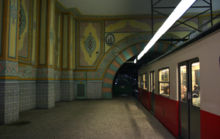
Sirkeci station is the final stop for all railways on the European side. Only one long-distance route runs daily (to Bucharest). Beyond the Bosphorus at the Haydarpasa station lines run several times daily to Ankara and more rarely to other destinations in Anatolia. For now the two stations are connected by ferry across the Bosphorus. The Marmaray project will eventually connect the rail system with an interchange station that will also connect with the metro system.
Traffic
The E5, E90 and Trans European Motorway (TEM) are the three main roads leading to Turkey from the European border and the innercity borders to the east. The motorway net around Istanbul is well developed and is constantly being extended. Motorways lead to Ankara and Edirne. There are also 2 expressways circling the city. The older one called E5 is mostly used for inner city traffic while the more recent TEM highway is mostly used by intercity or intercontinental traffic. The Bosphorus Bridge and the Fatih Sultan Mehmet Bridge respectively, provide the Bosphorus Strait passesages for these two highways.
Navigation
The port of Istanbul is the most important in the country. The old port at the Golden Horn serves primarily for personal navigation. Regular services as well as cruises exist to several ports such as Pireaus (Greece) and Greek islands, Dubrovnik (Croatia), Venice, Naples (Italy), Marseille (France), Haifa (Israel) in the Mediterranean Sea, and also Odessa (Ukraine) in Black Sea.
City and suburban traffic
Modern Buildings and structures with architectural significance
- Bridges
- Bosphorus Bridge
- Fatih Sultan Mehmet Bridge
- Galata Bridge
- Shopping malls
- Akmerkez
- Cevahir Mall
- Kanyon Mall
- Tepe Nautilus
- Shopping malls in Istanbul
- Sports venues
- Abdi İpekçi Arena
- Atatürk Olimpiyat Stadyumu
- Şükrü Saracoğlu Stadyumu
- Istanbul Park - Formula 1 Grand Prix Circuit
- Towers
- Camlica TV Tower
- Endem TV Tower
For a list of skyscrapers see List of tallest buildings in Europe.
Sports
Football
Istanbul is the homeland of many soccer teams; among them are three first division teams: Fenerbahçe SK, Galatasaray SK and Beşiktaş JK.
- Fenerbahçe (1907) have been national champions 16 times since 1959. The club's home games take place in the Şükrü Saracoğlu Stadium in the Kadiköy quarter. Its capacity is 52,500 spectators. Christoph Daum had been the Coach of the Turkish first league side from the summer of 2003 till the end of 2005-2006 season. Fenerbahçe is coached by Zico since July 2006. Fenerbahçe's most known players are Stephen Appiah, Mateja Kežman and the Brazilian midfielder Alexsandro de Souza.
- Galatasaray (1905) have been Turkish national champions 16 times since 1959 and won the UEFA Cup and the UEFA Super Cup in the year 2000. They play in the Ali Sami Yen Stadium, which has a capacity of 22,500 seats.
- Beşiktaş is the oldest Turkish sports association (1903). The 12 time national champion (The Besiktas total includes the Turkish Federation League, which was played for 2 seasons (1957 and 1958). Besiktas won this league both years.)
plays home games in the Inonu Stadium in the Beşiktaş district. It has a capacity of 32,000.
- Istanbulspor (1926) is the fourth biggest football club from Istanbul, now playing in the 2nd division. Despite having Istanbul in its name, Istanbulspor do not have many fans from Istanbul, unlike Galatasaray, Fenerbahce and Besiktas. The yellow-black side plays home games in the Güngören Stadium. Capacity of this stadium is 10,500.
Motor racing
Istanbul hosts Formula One Turkish Grand Prix, MotoGP Grand Prix of Turkey, FIA World Touring Car Championship, GP2 and Le Mans Series 1000 km races at the Istanbul Park.
Air racing
On July 29, 2006, İstanbul hosted the 4th round of the spectacular Red Bull Air Race World Series above Golden Horn.
Other sports
Other sports like basketball and volleyball are very popular. In addition to Fenerbahçe, Galatasaray and Beşiktaş, which field teams in multiple sports, other clubs have high profiles in those sports—among them Turkey's most prominent basketball clubs, Efes Pilsen and Fenerbahçe Ülker; and the Eczacibasi (Eczacıbaşı) and Vakifbank volleyball clubs. Golf, shooting, riding and tennis gain ever more significance. For Aerobic, bodybuilding and gymnastic equipment, numerous fitness clubs are available. Paintball belonges to the new kinds of sport and is already represented in two large clubs in the proximity of Istanbul. Eastern kinds of sport such as Aikido and Yoga have become more popular in recent years. There are several centers in the city where they can be exercised.
Popular Culture
Istanbul was included in many digital media such as:
- Strike Commander - Video Game
- Organized jobs - Movie
- James Bond 007: From Russia with Love - Video Game
- DRIV3R - Video Game
- The Net 2.0 - Movie
- The World Is Not Enough - Movie
- Topkapi - Movie
- From Russia with Love - Movie
- The Accidental Spy - Movie
- Crossing the Bridge: The Sound of Istanbul - Movie
- Istanbul (Not Constantinople) - Song
- Fullmetal Alchemist - Anime
Sister cities
Istanbul has 45 sister cities:
|
|
|
